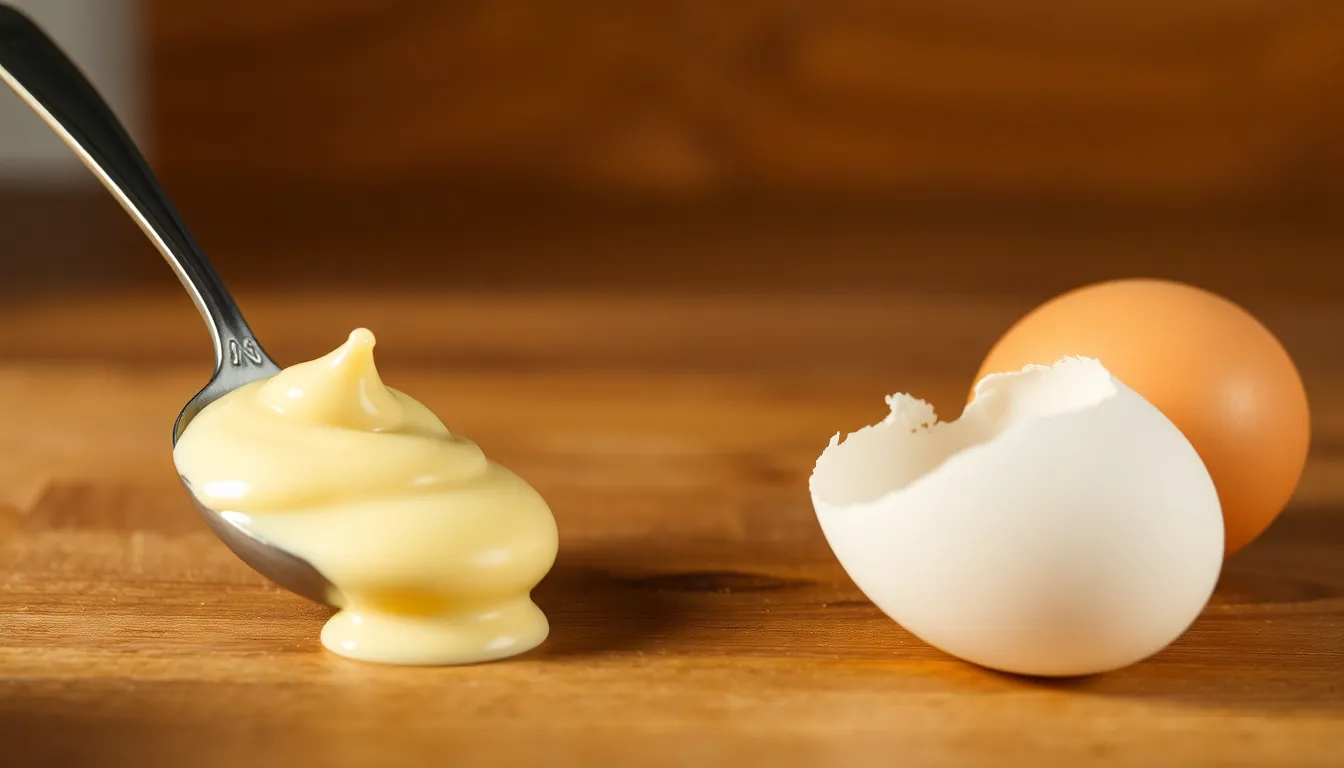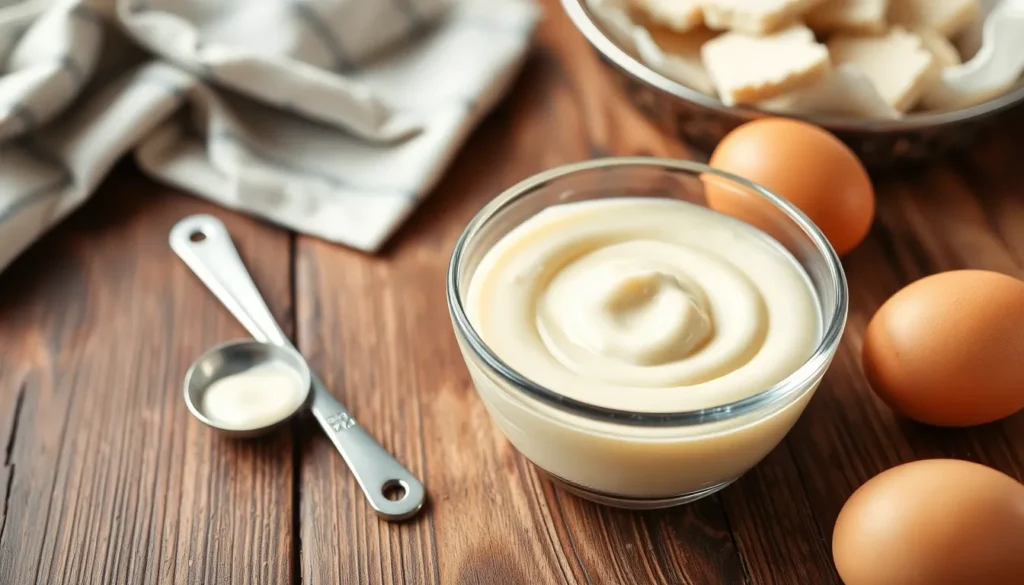When it comes to cooking and baking, eggs are often the unsung heroes of countless recipes. But what if someone’s out of eggs or just doesn’t want to crack one open? Enter mayonnaise—the creamy, spreadable miracle that can save the day. Surprisingly, this condiment can step in as a substitute for eggs, but how much mayo does it take to replace one egg?
Imagine whipping up a cake or a batch of cookies and realizing you’re eggless. Panic sets in, but fear not! With a dollop of mayo, you can keep the culinary show on the road. Let’s dive into the egg-citing world of mayo measurements and discover just how much of this tangy delight can do the trick. Who knew that a jar of mayonnaise could be a baker’s best friend?
Table of Contents
ToggleUnderstanding Egg Substitutes
Eggs contribute moisture and binding in recipes. Mayonnaise serves as an excellent substitute due to its ingredients. One tablespoon of mayonnaise can replace one egg in many dishes. This replacement works particularly well in baked goods like cakes or muffins.
Using mayonnaise offers a creamy texture and rich flavor. Many bakers appreciate this combination, especially in recipes that call for a moist result. Achieving a uniform consistency in mixtures becomes easier with mayonnaise, enhancing the final product’s texture.
Numerous alternatives exist when considering egg substitutes. Applesauce, mashed bananas, and yogurt serve as popular choices. Each alternative has unique properties that fit various recipes.
When measuring these substitutes, understanding the ratios matters. Typically, three tablespoons of applesauce replace one egg. On the other hand, a quarter cup of yogurt can also substitute one egg effectively.
Overall, mayonnaise stands out for its convenience and effectiveness. Bakers seeking egg replacements can rely on this condiment, simplifying the process without sacrificing quality. Incorporating mayonnaise into baking adds an unexpected twist and ensures delightful outcomes.
How Much Mayonnaise Equals One Egg

One tablespoon of mayonnaise replaces one egg in many recipes. This replacement is popular for its consistency and moisture, making it suitable for various dishes.
The Science Behind Substitutions
Substituting mayonnaise for eggs hinges on its composition. Mayonnaise combines oil, egg yolks, and vinegar or lemon juice, offering emulsification and moisture. When utilized in baking, it retains flavors while enhancing texture. Baking relies on eggs for binding and leavening, and mayonnaise fulfills these roles effectively. This substitution works particularly well in denser foods like cakes and brownies. Science shows that the fat content in mayonnaise enables similar structural development as whole eggs.
Flavor and Texture Considerations
Flavor and texture significantly affect the success of the substitution. Mayonnaise introduces a creamy taste that complements many baked goods. In cakes, muffins, or quick breads, mayonnaise promotes a moist, tender crumb. Since mayonnaise has a mild flavor, it often goes unnoticed in the final product. Recipes requiring a rich, dense texture benefit especially from this replacement. Remember to adjust the recipe slightly for added moisture when using mayonnaise to ensure balanced results.
Recipe Applications
Mayonnaise serves as a versatile ingredient in many culinary applications. It effectively replaces eggs in various recipes, enhancing texture and flavor.
Baking with Mayonnaise
Baking often benefits from the inclusion of mayonnaise. One tablespoon of mayonnaise replaces one egg, making it a convenient choice for cakes and brownies. Moisture retention enhances the final product, leading to a tender crumb. It also contributes an enriched flavor profile without overwhelming other ingredients. Recipes may require slight adjustments for optimal moisture balance, but the results are often delightful. Many bakers appreciate this simple substitution for its ease.
Cooking and Sauces
Mayonnaise plays a vital role in cooking and sauce preparation. It acts as a robust emulsifier in salad dressings, providing creaminess and stability. One tablespoon of mayonnaise can replace one egg in recipes for creamy sauces and dips. Adjustments to seasoning may enhance overall flavor, ensuring a well-rounded dish. Chefs often rely on mayonnaise for its ability to bind ingredients while enriching taste. This ingredient opens doors for endless culinary possibilities, making it an essential component in many kitchens.
Pros and Cons of Using Mayonnaise
Mayonnaise serves as a practical egg substitute in various recipes. Its creamy texture enhances baked goods while providing moisture. One tablespoon of mayonnaise effectively replaces one egg, making measurement simple.
Using mayonnaise has several benefits. It acts as an emulsifier, binding ingredients together seamlessly in dressings and sauces. This enhances the flavor profile, creating rich, creamy outcomes. The substitution contributes to a tender crumb in cakes and muffins, often yielding better results than egg-free options.
There are drawbacks to consider as well. Some individuals may dislike the taste of mayonnaise, which could alter the dish’s flavor. Food allergies also pose a concern, as mayonnaise contains eggs, making it unsuitable for those with egg allergies.
When adjusting recipes, it’s crucial to account for additional moisture. Too much mayonnaise may lead to overly moist or dense baked goods. Adjusting the liquid content in a recipe helps maintain balance.
Mayonnaise’s versatility in various culinary applications cannot be overlooked. It opens up new possibilities for those seeking egg alternatives. Overall, he or she should weigh the pros and cons based on personal preference and dietary restrictions.
Using mayonnaise as an egg substitute offers a practical solution for those looking to enhance their culinary creations. With just one tablespoon replacing an egg, it provides moisture and a creamy texture that elevates baked goods. This versatile ingredient not only works well in cakes and brownies but also shines in dressings and sauces.
While it brings numerous benefits to the table, considering personal taste and dietary needs is essential. Whether opting for mayonnaise or exploring other substitutes like applesauce or yogurt, understanding the unique properties of each can lead to successful and delicious dishes. Embracing these alternatives can open up a world of flavor and texture in the kitchen.




